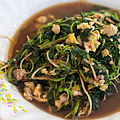Amaranthus spinosus
-
Amaranthus spinosus plant
-
Phat phak khom dish
-
Cenex gas station in Gillette, Wyoming
Amaranthus spinosus[edit]
Amaranthus spinosus, commonly known as spiny amaranth or thorny amaranth, is a species of annual plant in the Amaranthaceae family. It is native to the tropical regions of the Americas but has become a widespread weed in many parts of the world.
Description[edit]
Amaranthus spinosus is characterized by its erect, branching stems that can grow up to 1.5 meters tall. The plant is easily identified by its sharp spines located at the base of the leaves. The leaves are simple, alternate, and have a lanceolate to ovate shape with a smooth margin. The plant produces small, greenish flowers that are arranged in dense clusters known as inflorescences. These inflorescences are typically found at the terminal ends of the stems and in the leaf axils.
Habitat and Distribution[edit]
Amaranthus spinosus thrives in a variety of habitats, including agricultural fields, gardens, roadsides, and waste areas. It prefers warm and humid environments and is commonly found in tropical and subtropical regions. The plant has been introduced to many parts of the world, including Africa, Asia, and Australia, where it is often considered an invasive species.
Ecological Impact[edit]
As a weed, Amaranthus spinosus can compete with crops for nutrients, water, and light, potentially reducing agricultural yield. Its presence in crop fields can also complicate harvesting and management practices. The plant's ability to produce a large number of seeds contributes to its rapid spread and persistence in disturbed environments.
Uses[edit]
Despite its status as a weed, Amaranthus spinosus has several uses. In some cultures, the young leaves and stems are consumed as a leafy vegetable. The plant is also used in traditional medicine for its purported anti-inflammatory, diuretic, and antipyretic properties. However, care should be taken when using the plant for medicinal purposes, as it may contain nitrates and oxalates that can be harmful in large quantities.
Control and Management[edit]
Controlling Amaranthus spinosus involves a combination of mechanical, chemical, and cultural methods. Mechanical control includes hand pulling or hoeing before the plant sets seed. Chemical control involves the use of herbicides, although resistance to certain herbicides has been reported. Cultural control strategies include maintaining healthy crop stands and using mulches to suppress weed growth.
Related Pages[edit]
Ad. Transform your life with W8MD's Budget GLP-1 injections from $75


W8MD offers a medical weight loss program to lose weight in Philadelphia. Our physician-supervised medical weight loss provides:
- Weight loss injections in NYC (generic and brand names):
- Zepbound / Mounjaro, Wegovy / Ozempic, Saxenda
- Most insurances accepted or discounted self-pay rates. We will obtain insurance prior authorizations if needed.
- Generic GLP1 weight loss injections from $75 for the starting dose.
- Also offer prescription weight loss medications including Phentermine, Qsymia, Diethylpropion, Contrave etc.
NYC weight loss doctor appointmentsNYC weight loss doctor appointments
Start your NYC weight loss journey today at our NYC medical weight loss and Philadelphia medical weight loss clinics.
- Call 718-946-5500 to lose weight in NYC or for medical weight loss in Philadelphia 215-676-2334.
- Tags:NYC medical weight loss, Philadelphia lose weight Zepbound NYC, Budget GLP1 weight loss injections, Wegovy Philadelphia, Wegovy NYC, Philadelphia medical weight loss, Brookly weight loss and Wegovy NYC
|
WikiMD's Wellness Encyclopedia |
| Let Food Be Thy Medicine Medicine Thy Food - Hippocrates |
Medical Disclaimer: WikiMD is not a substitute for professional medical advice. The information on WikiMD is provided as an information resource only, may be incorrect, outdated or misleading, and is not to be used or relied on for any diagnostic or treatment purposes. Please consult your health care provider before making any healthcare decisions or for guidance about a specific medical condition. WikiMD expressly disclaims responsibility, and shall have no liability, for any damages, loss, injury, or liability whatsoever suffered as a result of your reliance on the information contained in this site. By visiting this site you agree to the foregoing terms and conditions, which may from time to time be changed or supplemented by WikiMD. If you do not agree to the foregoing terms and conditions, you should not enter or use this site. See full disclaimer.
Credits:Most images are courtesy of Wikimedia commons, and templates, categories Wikipedia, licensed under CC BY SA or similar.
Translate this page: - East Asian
中文,
日本,
한국어,
South Asian
हिन्दी,
தமிழ்,
తెలుగు,
Urdu,
ಕನ್ನಡ,
Southeast Asian
Indonesian,
Vietnamese,
Thai,
မြန်မာဘာသာ,
বাংলা
European
español,
Deutsch,
français,
Greek,
português do Brasil,
polski,
română,
русский,
Nederlands,
norsk,
svenska,
suomi,
Italian
Middle Eastern & African
عربى,
Turkish,
Persian,
Hebrew,
Afrikaans,
isiZulu,
Kiswahili,
Other
Bulgarian,
Hungarian,
Czech,
Swedish,
മലയാളം,
मराठी,
ਪੰਜਾਬੀ,
ગુજરાતી,
Portuguese,
Ukrainian


